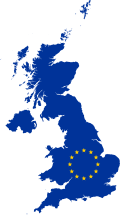This article needs to be updated. (June 2023) |
 Map of the United Kingdom (orange) and the European Union (blue) | |
| Type |
|
|---|---|
| Condition | Ratification by the Council of the European Union, the European Parliament, and the Parliament of the United Kingdom. |
| Negotiators |
|
| Parties | |
| Full text | |
| |
| Part of a series of articles on |
| UK membership of the European Union (1973–2020) |
|---|
 |
Between 2017 and 2019, representatives of the United Kingdom and the European Union negotiated the terms of Brexit, the UK's planned withdrawal from membership of the EU. These negotiations arose following the decision of the Parliament of the United Kingdom to invoke Article 50 of the Treaty on European Union, which in turn followed the UK's EU membership referendum on 23 June 2016 in which 52% of votes were in favour of leaving.
The negotiating period began on 29 March 2017, when the United Kingdom served its withdrawal notice under Article 50. The withdrawal was then planned to occur on 29 March 2019, two years after the date of notification as specified in Article 50.
Negotiations formally opened on 19 June 2017 when David Davis, the UK's Secretary of State for Exiting the European Union, met Michel Barnier, the EU's Chief Negotiator.[2] They began to discuss a withdrawal agreement, which included terms of a transitional period and an outline of the objectives for a future UK–EU relationship.
In March and April 2019, Prime Minister of the United Kingdom Theresa May and the European Council agreed to move the date of the UK's departure to 31 October 2019.[3][4]
May resigned as leader of the ruling Conservative Party on 7 June 2019,[5] and on 23 July, Boris Johnson was elected as her successor.[6] The Johnson ministry and EU agreed to resume regular meetings to discuss the withdrawal agreement on 28 August 2019,[7] but the UK declared a precondition that the Irish backstop must be scrapped, which the EU said it would not accept.[8][9]
In October 2019, following bilateral talks between Johnson and Leo Varadkar (the Taoiseach, Johnson's Irish counterpart),[10] the UK and EU agreed to a revised deal, which replaced the backstop. In the new Northern Ireland protocol, the entire UK would be removed from the EU Customs Union as a single customs territory. Northern Ireland will be included in any future UK trade deals, but it remains an entry point into the EU Customs Union, creating a de facto customs border between Northern Ireland and Great Britain. Following the 2019 UK general election, which returned a Conservative majority, the Withdrawal Agreement Bill and its programme motion passed its first reading in the House of Commons.
The agreement was ratified by the UK, on 23 January 2020,[11] and by the EU on 29 January 2020,[12] confirming that a withdrawal agreement was in place when, as planned, the UK left the EU on 31 January 2020.
The withdrawal was followed by trade negotiation between the UK and the EU, which resulted in the EU–UK Trade and Cooperation Agreement (TCA), signed on 30 December 2020.
- ^ "Theresa May takes personal charge of Brexit talks". BBC News. 24 July 2018. Archived from the original on 17 January 2021. Retrieved 8 November 2018.
- ^ Sparrow, Andrew (19 June 2017). "UK appears to capitulate on sequencing on first day of Brexit talks – as it happened". The Guardian. Archived from the original on 1 April 2019. Retrieved 23 June 2017.
- ^ "Brexit pushed back by at least two weeks". 22 March 2019. Archived from the original on 22 March 2019. Retrieved 22 March 2019.
- ^ "Brexit: UK and EU agree delay to 31 October". 11 April 2019. Archived from the original on 11 April 2019. Retrieved 11 April 2019.
- ^ Stewart, Heather (24 May 2019). "Theresa May announces she will resign on 7 June". Archived from the original on 24 May 2019. Retrieved 30 June 2019.
- ^ "Boris Johnson wins race to be Tory leader and PM". 23 July 2019. Archived from the original on 21 January 2021. Retrieved 24 July 2019.
- ^ Heather Stewart, Severin Carrell and Jennifer Rankin (29 August 2019). "Time to step up tempo of Brexit talks, says bullish Boris Johnson". The Guardian. Archived from the original on 29 August 2019. Retrieved 30 August 2019.
- ^ Peter Walker (26 July 2019). "UK on course for no-deal Brexit as Johnson rejects EU agreement". The Guardian. Archived from the original on 26 July 2019. Retrieved 26 July 2019.
- ^ Boffey, Daniel; Rankin, Jennifer (12 September 2019). "Michel Barnier: no grounds for reopening Brexit talks". The Guardian. Archived from the original on 30 July 2021. Retrieved 30 July 2021.
- ^ "Brexit: Boris Johnson and Leo Varadkar 'can see pathway to a deal'". BBC News. 10 October 2019. Archived from the original on 30 October 2019. Retrieved 23 December 2019.
- ^ "Brexit: UK has 'crossed Brexit finish line', says Boris Johnson". bbc.co.uk. 22 January 2020. Archived from the original on 30 January 2020. Retrieved 30 January 2020.
- ^ "Brexit: European Parliament overwhelmingly backs terms of UK's exit". bbc.co.uk. 29 January 2020. Archived from the original on 29 January 2020. Retrieved 30 January 2020.